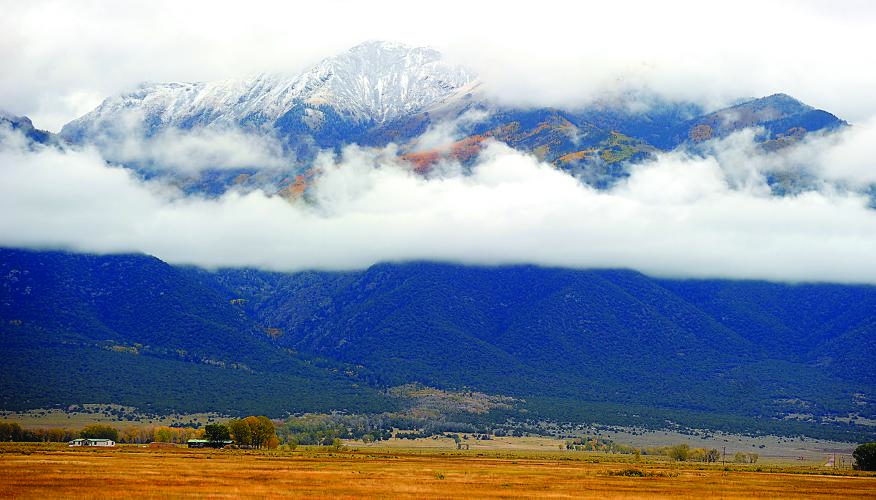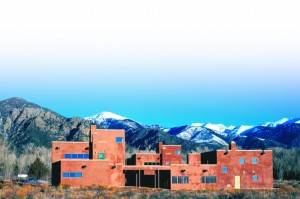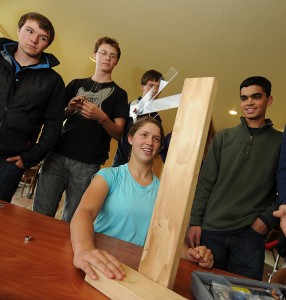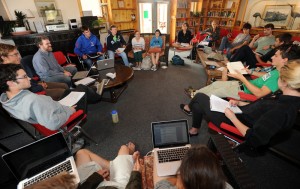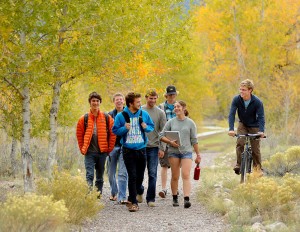Prof. Dennis McEnnerney runs through the schedule as 16 bleary-eyed, first-year students arrange chairs in a circle and settle into a cozy pine-ceilinged library.
“Start reading Huxley for Friday. We’ll leave for the hot springs at 7:15 tonight. Tomorrow you’ll be presenting with your small groups; we’ll take 20 minutes to talk about each proposal and then grab lunches and head to the sand dunes. Proposal topics?”
The students, in hoodies, fleece and soccer jackets, feet clad in sneakers and flip-flops, offer possibilities based on their readings of Voltaire, Kant, Thomas Kuhn, and Aldous Huxley, for their Blocks 1 and 2 class, Freedom and Authority.
“Modern society and democracy?”
“Liberal societies, something about religion?”
“Modern individualism, reason and emotion.”
An hour into class, the conversation is cooking with interjections and debate. McEnnerney, adjunct associate professor of philosophy, steers the students through the Enlightenment thinkers, the spread of ideas, public opinion, Kuhn’s philosophy on science and that “we may have to give up this idea of truth.” Students who were quiet at first are now bursting into the discussion about paradigms, evolution vs. creationism, Nazi Germany, objectivity.
Outside, it’s a crisp 49 degrees. The umber landscape is punctuated by purple asters, sage, and deep orange aspens. A shelf of clouds is lifting to reveal the season’s first snow on the Sangre de Cristo Range. And it is quiet. So quiet.
It’s been 25 years since Joe Gordon, professor of English, took the first reluctant Colorado College class to the Baca, then an Aspen Institute for Humanistic Studies property. The students were seniors studying literature of the wilderness that block in February 1987, and while at Baca, next to tiny Crestone, Colo., they delved into “The Odyssey.”
“Miraculously, all the pieces came together,” Gordon wrote in a 1993 issue of “la Tertulia,” the Southwest studies newsletter. “We analyzed Homer in the mornings, took long hikes in the mountains in the afternoons, shared the cooking and cleaning, and watched and discussed films at night. I can still remember the crunch of the snow, the smell of piñon smoke, the sharpness of the night air, and the sky full of stars as we walked back from the seminar building after a late movie. Most of the students were from large urban and suburban areas. They were struck by the silence around them, the deer that browsed by the path, the coyotes that howled them to sleep at night. One student from a large city complained that it was so quiet he couldn’t sleep.”
Those students returned and urged other professors to take classes to the Baca. In the first three “trial” years, more than 3,000 students stayed at Baca with their classes. In 1990, the McHugh Family Foundation provided funding to buy 300 acres of land, a conference center, and one townhouse. Soon after, the Baca Lodge, a three-building complex to house students, was funded by trustee Edith Gaylord Harper, as well as trustees Thayer Tutt and William Hybl via El Pomar. The Baca Lodge was dedicated in October 1992.
Now, about 55 classes a year, plus groups, seminars, retreats, and conferences draw about 1,300 CC people a year to Baca’s grand vistas, dark night skies, and the quiet of the San Luis Valley.
At lunchtime at the Desert Sage Café, Andrea Bruder, assistant professor of mathematics and computer science, explains why she and Jane McDougall, assistant professor of mathematics, brought their Calculus and Mathematical Chaos class to Baca. This afternoon her class will build a double pendulum to illustrate chaotic behavior.
“This is a chance to get away from the distractions on the main campus,” Bruder says. “We are introducing them to the most complicated mathematical concepts they have dealt with, and it’s important that they can speak about it correctly. So this gives them time to talk about it. It’s also a way for the group to bond, to get to know one another.”
“Being alone with your class is cool,” says Alex Suber ’15, a first-year from Highland Park, Ill. “Like last night, when we had a debate over whether control was the same thing as power, relating it back to the text.”
In the calculus class, Cholpon Tuzabaeva ’15, a first-year student from the Kyrgyzstan Republic, says she appreciates the chance to work closely with classmates.
“Here, you can really devote yourself to the class,” she said. “Usually it’s hard to find each other when you have questions or homework, but here, you can ask questions at night and we can talk about it.”
That collaborative spirit is common at Baca. CC Chaplain Bruce Coriell remembers a class on Shamanism, for which only three copies of the 600-page text had arrived at CC’s bookstore by the time the class departed for Baca. Students set up reading groups, and discussed concepts until everyone understood them. “They had a greater understanding of that book than ever before,” Coriell said. “The scarcity of resources bonded them.”
There is only one road in and out, and Crestone, a haven for spiritual centers and seekers, is at the end of it. Prayer flags adorn the rooflines of a couple of the buildings. A sign reads, “Encourage Innocent Amusement.” Bulletin boards are covered with fliers for spiritual seminars, tarot readings, even cooking with yoga classes. A gift shop sells bumper stickers that read, “I tried to leave Crestone but the vortex pulled me back.”
Vortex or not, the Baca has been magnetic for CC students and professors.
“Over the years, students would compete for the title of Most Baca Visits,” says Coriell. “There was a whole thing about ‘majoring in Baca.’ ”
Jana Bennett ’98 was one of them. While a CC history major, she visited the Baca between 20 and 25 times, taking courses taught by History Professor Carol Neel, then-President Kathryn Mohrman, Philosophy Professor John Riker and Classics Professor Marcia Dobson, among others. Block breaks there included Writing Center retreats and Shove Council gatherings. She found the range of religious traditions and the townspeople inspiring.
“Once I had a 15-page paper for Carol Neel’s class, and I was freaking out. But somehow the Baca gave me the space to write that paper, a way of believing in myself. It’s like the townspeople, who are kind of scrappy, got there by hook or crook, in those rugged mountains. There’s a sense of determination, that ‘yes, you can do it,’ that pervades there.”
Now an assistant professor of religious studies at the University of Dayton, she wishes her own students had a place like the Baca. “I think it’s one of the great, unique things about Colorado College,” she said. “Whenever I tell people about CC, I tell them about Baca.”
Physics Professor Dick Hilt is another Baca devotee, drawn to the dark night skies – a perfect spot for his astronomy classes. He started off taking one class a year to Baca, then two. Now, it’s four or five blocks a year. He books the space far ahead, timed for his students to view key planetary and star events.
He remembers walking one night with his students back from a talk at the Carmelite monastery.
“You could see the road barely by starlight; you knew you were on it only if you felt asphalt beneath your feet. You could walk and look at the sky, not even watch where you were going, and it was marvelous.”
Join the conversation: Share your memories and comments about the Baca below.
